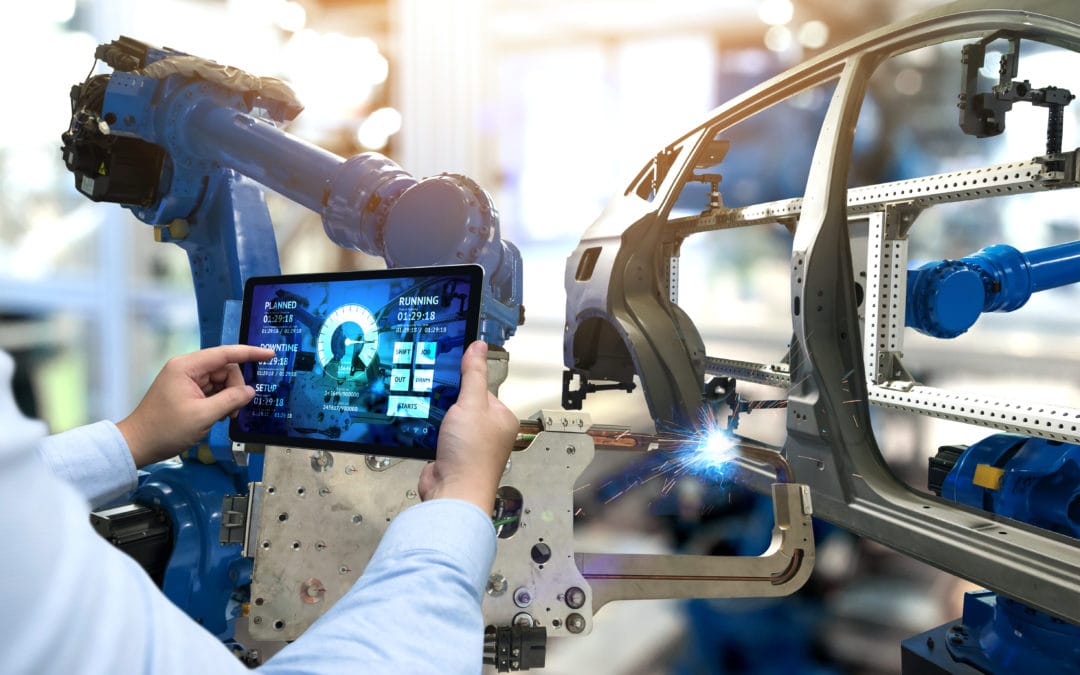It’s no surprise that over the last several years automotive manufacturing has been experiencing a resurgence in growth. New companies, new models, new players, new technology – it’s an exciting industry to be in. And although there is definitely a lot of ‘new’, when it comes to digital, automotive has always been ahead of the curve. I mean, lets face it, automotive was digital before it was even a buzzword…so what do we see that’s different?
With the fast and furious emergence of IoT offerings of late, we’ve seen our automotive customers step up, yet again, to embrace technology. Today it’s more about integrating and connecting their digital investments, with IoT bringing the promise of connectivity and advanced learning.
Picture a typical automotive plant – a plethora of automated equipment, robotics, presses, paint shops, automated cells, lathes, mills, torque guns, balancers, conveyors, ASRS, AGVs – the list goes on and on. And most have some sort of technology under the hood – from a sophisticated, modern control system to a proprietary PC-based database, and everything in between.
The consequence of all these years of automation and technology investments is a mess of disparate systems and islands of information across the manufacturing operation. This typically involves a wide range of systems, from legacy applications, vision systems, and home-grown solutions, to pilots that someone in maintenance or quality developed over in a corner workstation to get the job done. All these systems are likely producing valuable data, but like many in the automotive environment, not collected or utilized in a manner that’s propelling the business forward.
We hear customers say things like: “when something goes wrong, I have to go collect data from two or three systems, export it to excel and then spend time analyzing it. It takes hours out of my day, and by the time I identify the problem, it’s either too late to make an impact or another issue has come up that takes precedence”.
So how do you integrate all these solutions to provide useful insights? How do you do it in an environment where things are always changing? New product launch is months away — there’s no time to build a spaceship.
When we look at our customers, we’re seeing them use IoT for two things:
- To provide quick-to value solutions that are scalable and bring visibility and actionable insights to the operation, and
- To connect disparate systems and pull together islands of information on the plant floor
We’ve recently worked with a global automotive supplier who started a Smart Manufacturing initiative more than 2 years ago but abandoned it due to slow progress. With 40+ facilities across a dozen countries, all with unique processes, equipment, and solutions in place, the problem they were faced with was whether to try to build and customize a solution internally, consuming substantial time and resources, or look for a better option leveraging IoT.
With numerous legacy, home-grown, and pilot solutions throughout the facility, the customer wanted a solution that would allow them to pull together real-time and historical data from various sources on the plant floor and provide specific user groups actionable insights and troubleshooting capabilities. Furthermore, the customer wanted an IoT solution that was quick-to-value and repeatable, allowing them to get this valuable functionality in their hands sooner so they could then improve on and tweak it before moving forward with a full enterprise deployment – in short, they wanted to go from years to months.
The solution developed was a multi-line pilot with disparate data sources shown in mashups geared toward various user groups, from plant managers to line operators, which could then be customized based on personnel and plant needs. The project was approached with an agile methodology, with a project roadmap made up of short sprints rather than a traditional waterfall method. This approach proved to the customer the solution worked, and could provide them the type of actionable insights they required to make smart business decisions, fast. From there, a program roadmap was established detailing what enhancements would be added to the solution and when and how the rollout would take place. This is a great example of what we’re hearing and seeing across the automotive environment, as customers look to realize benefits quickly and move to the next win. Benefits such as added visibility into plant floor operations leading to things like decreased downtime and reduced scrap, which were the drivers for the customer example mentioned above.
The case outlined leverages PTC’s ThingWorx platform. The solution lends itself to our rapid development approach, and to bringing smart, connected assets together quickly so that the automotive supplier can utilize valuable data from the plant floor sooner. We’re seeing an uptick in our business from customers using Thingworx as their go-to IoT platform, and only see this growing based on the recent news of Rockwell Automation’s $1B investment in PTC. It’s an exciting time for us as an integrator to be in the middle of all of these industry and market changes and we’re happy to share our perspectives on digital, IOT and moving fast.
If you’d like to learn about this particular project or have any questions, please reach out and we’d be happy to walk you through some more detailed material.

